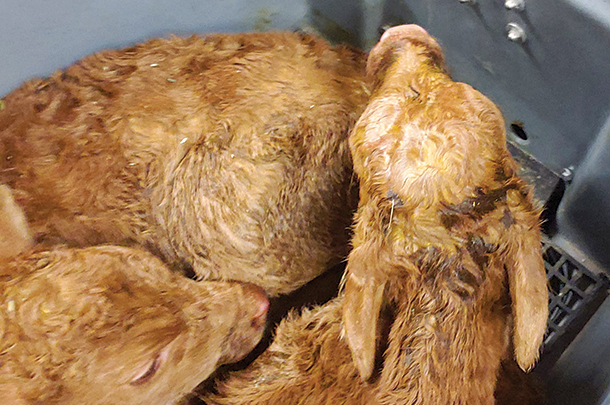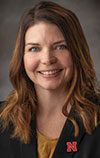Spring calving in the Midwest has its fair share of unfortunate weather events. From the 2019 bomb cyclone to the 2021 polar vortex, cattle producers should not be surprised when the weather forecasts the worst. The saying goes, “Hope for the best, plan for the worst.”
Plans for calving season should include how to identify and manage cold stress in newborns. In the 2007 National Animal Health Monitoring System report, 25.6% of operations reported weather as the main cause for death in calves less than 3 weeks old. Preventing hypothermia is vital to survival in the newborn.
Thermoregulation is the process of regulating body heat, regardless of the environmental temperature. The range of temperature where calves require the smallest amount of metabolic regulation is defined as the thermoneutral zone. This varies from 59ºF to 77ºF, depending on calf age, size and environmental stressors. When temperatures drop below 59ºF, calves rely on increased metabolic rate to stay warm. Long-term exposure to temperatures below 56ºF can lead to cold stress. It is important to remember that environment can play a large role in how calves react to cold stress. A driving rain and wind will be harder on calves than 30ºF and dry sunshine.
Mechanisms of thermoregulation
There are multiple ways newborn calves generate heat. The first is through shivering, which is defined as the processes of involuntary contractions of muscle fibers to release heat. Newborn calves born in temperatures below the lower critical temperature will shiver as they begin to dry off. A study in 1999 found that supplementing fat in the dam’s diet during late gestation led to an increase of glucose in the newborn calf. This is valuable, as glucose is used to initiate the shivering process.
Another way to generate heat is through a substance called brown adipose tissue (BAT). Also known as brown fat, it is a specialized organ that contains more blood vessels than white fat. As a result, the cells in BAT are full of mitochondria, which helps the body convert energy into heat. Up to 2% of a newborn calf’s bodyweight comes from BAT, and it regresses as the calf ages.
Interruptions to thermoregulation
Difficulty during birth, also known as dystocia, can have detrimental effects on calf health. The contractions from the dam create periods of limited oxygen as the calf moves through the birth canal. When the delivery process is prolonged, calves will be born with critically low levels of blood oxygen. These low levels will be corrected when breathing begins.
However, severe dystocia calves have such low levels that the respiratory system is suppressed, leading to a cascade of negative events. The increase of blood carbon dioxide levels and the lack of oxygen lead to a condition called acidosis. The acidosis will depress the central nervous system and lead to weak calf syndrome. In these situations, calves are unable to stand and likely have a decreased shivering response, causing hypothermia. Hypothermic calves lack a suckle reflex and fail to ingest necessary colostrum, which will delay the absorption of antibodies and essential nutrients needed for survival.
Management strategies to treat hypothermia
There are several ways to assist a hypothermic calf. The first step is understanding when to intervene. The normal rectal temperature of a newborn calf is 101.5ºF to 102.5ºF. A simple thermometer will help identify when the calf is in danger. Once the temperature drops below 101ºF, steps should be taken to prevent hypothermia. Another tip is to place two fingers into the mouth of the calf. The inside of the mouth of a healthy calf will be warm and moist and will attempt to chew or suck on your fingers. If the suckle reflex is absent, it’s time to get involved. Always remember to “go with your gut.”
 Use equipment and management methods to prevent hypothermia in calves, which limits calves’ ability to suckle and maintain energy. Photo by Paul Marchant.
Use equipment and management methods to prevent hypothermia in calves, which limits calves’ ability to suckle and maintain energy. Photo by Paul Marchant.
Consider two routes when attempting to rewarm a calf: external and internal. Colostrum is the first line of defense for warming a calf internally. Comprised of up to 10% fat, colostrum acts as a heat source by burning the fat into energy and maintaining body temperature. Calves that can sit sternal and hold their head up need colostrum to begin the warming process. The best source will be from the dam, but other sources or replacers may be used as well. Ensure records are kept on what and how much was provided to the calf.
Several external heat sources are available and depend on what works best in your operation. Commercial heat huts are convenient ways to circulate warm air around a newborn calf. This option is nice when calves are wet and need a chance to dry before going back outside. Remember to check the temperature of the calf often and remove from the heat source once rectal temperature reaches 100ºF and the calf begins to show positive signs of vigor.
Never leave a calf unattended for several hours, as there is potential for overheating. While warming huts are an easy option, they can also serve as breeding grounds for pathogens. Thoroughly clean and disinfect the entire hut before adding another calf. The concept of a commercial hut can be replicated wherever warm forced air is available. Hair dryers, heaters and floor beds of trucks can all be great options for chilled calves.
Another choice is a warm-water bath. Placing a calf in a 100ºF water bath will slowly warm him back to optimal temperature. Mineral tubs, tanks or old bathtubs can be converted into a lukewarm hot tub, adding more water as needed to maintain 100ºF. Placing a calf halter on the head or loosely tying a life jacket around the calf’s neck will help keep the calf afloat. Again, continue checking rectal temperature until the calf is ready to be removed from the water. It is imperative that his coat is dry before placing him back outside.
Understanding the risk factors for hypothermia will aid in developing a strategy to prevent loss. Managing dystocia and knowing when and how to assist chilled calves is an essential part of your calving plan.









